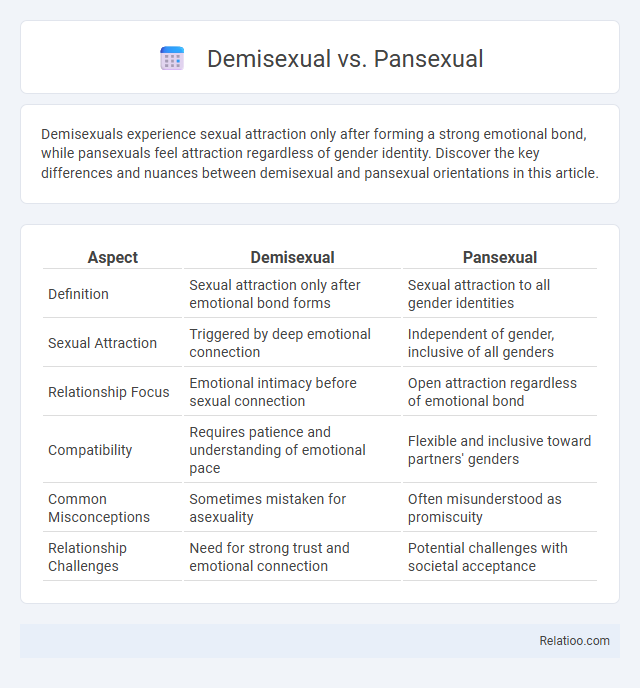Demisexuals experience sexual attraction only after forming a strong emotional bond, while pansexuals feel attraction regardless of gender identity. Discover the key differences and nuances between demisexual and pansexual orientations in this article.
Table of Comparison
| Aspect | Demisexual | Pansexual |
|---|---|---|
| Definition | Sexual attraction only after emotional bond forms | Sexual attraction to all gender identities |
| Sexual Attraction | Triggered by deep emotional connection | Independent of gender, inclusive of all genders |
| Relationship Focus | Emotional intimacy before sexual connection | Open attraction regardless of emotional bond |
| Compatibility | Requires patience and understanding of emotional pace | Flexible and inclusive toward partners' genders |
| Common Misconceptions | Sometimes mistaken for asexuality | Often misunderstood as promiscuity |
| Relationship Challenges | Need for strong trust and emotional connection | Potential challenges with societal acceptance |
Understanding Demisexuality: Definition and Key Traits
Demisexuality is defined by experiencing sexual attraction only after forming a strong emotional connection, distinguishing it from pansexuality, which involves attraction to individuals regardless of gender. Key traits of demisexuality include limited or absent initial sexual attraction and a focus on deep emotional bonds as a prerequisite for sexual desire. Understanding demisexuality enhances recognition of diverse sexual orientations and emphasizes the importance of emotional intimacy in sexual attraction.
What Does It Mean to Be Pansexual?
Pansexual refers to a sexual orientation characterized by attraction to individuals regardless of their gender identity or biological sex, embracing a broad spectrum of gender expressions. Unlike demisexuality, which involves experiencing sexual attraction only after forming a strong emotional connection, pansexuality is defined by openness to all genders without specific emotional prerequisites. Understanding pansexuality highlights inclusivity beyond traditional gender binaries, distinguishing it from demisexual and other orientations by its inherent acceptance of diverse gender identities.
Core Differences Between Demisexual and Pansexual Identities
Demisexuality is characterized by experiencing sexual attraction only after forming a strong emotional connection, while pansexuality involves attraction to individuals regardless of their gender identity. Your understanding of these identities highlights that demisexuals prioritize emotional bonds before sexual attraction, whereas pansexuals have a more inclusive approach to gender in their attractions. Recognizing these core differences helps clarify the unique experiences within the spectrum of sexual orientations.
The Role of Emotional Connection in Demisexuality
Demisexuality is characterized by the need for a strong emotional connection before experiencing sexual attraction, distinguishing it from pansexuality, which involves attraction regardless of gender. Your emotional bond plays a crucial role in demisexual relationships, as sexual attraction typically arises only after trust and intimacy are established. Understanding this nuance helps clarify how demisexual individuals navigate attraction differently compared to pansexual identities.
Pansexuality: Attraction Beyond Gender
Pansexuality represents an orientation characterized by attraction to individuals regardless of their gender identity or biological sex, emphasizing the fluidity and inclusivity of human connections. Demisexuality, including individuals who identify as demisexual, requires a deep emotional bond before experiencing sexual attraction, highlighting the importance of emotional intimacy over gender in their relationships. You can explore these distinctions to better understand how attraction varies, with pansexuality focusing on attraction beyond gender and demisexuality centering on the prerequisite of emotional connection.
Misconceptions About Demisexual and Pansexual Orientations
Misconceptions about demisexuality often include the belief that demisexual individuals are simply picky or that their orientation is a phase, whereas demisexuality is a recognized sexual orientation characterized by attraction only after forming strong emotional bonds. Pansexuality is frequently misunderstood as being confused with bisexuality, but it specifically denotes attraction to people regardless of gender identity, highlighting its inclusivity. Understanding these distinctions helps clarify your identity and fosters respect for diverse experiences within the LGBTQ+ community.
Overlapping Experiences: Shared Challenges and Insights
Demisexual and pansexual individuals often navigate overlapping experiences related to identity validation and societal misunderstanding, which can impact mental health and relationship dynamics. Challenges such as explaining nuanced attractions to others and finding inclusive communities highlight the importance of awareness and empathy in fostering acceptance. Your increased understanding of demisexuality and pansexuality can promote connection and support within diverse sexual orientations.
Coming Out as Demisexual vs Pansexual
Coming out as demisexual often involves explaining the experience of forming sexual attraction only after a strong emotional bond, which contrasts with pansexuality's attraction to all gender identities regardless of emotional connection. Demisexual individuals might face misunderstanding due to less visibility and awareness compared to pansexuality, which is more broadly recognized within LGBTQ+ communities. Clear communication about demisexuality helps foster acceptance by highlighting its unique spectrum within asexual and sexual orientations, especially during the coming out process.
Representation in Media and Popular Culture
Representation of demisexuality and pansexuality in media and popular culture remains limited but is gradually increasing, highlighting diverse sexual orientations beyond traditional binaries. Pansexual characters often appear in mainstream media, depicted as attracted to all genders, while demisexuality is less frequently explored but gaining visibility through nuanced portrayals in web series, literature, and LGBTQ+ advocacy platforms. This growing representation helps challenge stereotypes, fostering broader understanding and inclusivity within media narratives.
Supporting Demisexual and Pansexual Individuals
Supporting demisexual and pansexual individuals requires understanding the unique nature of their sexual orientations and respecting their need for emotional connection and fluid attraction. Providing inclusive environments and using affirming language helps validate their identities and promotes mental well-being. Access to targeted resources and community support networks strengthens acceptance and reduces stigma for both demisexual and pansexual people.

Infographic: Demisexual vs Pansexual
 relatioo.com
relatioo.com